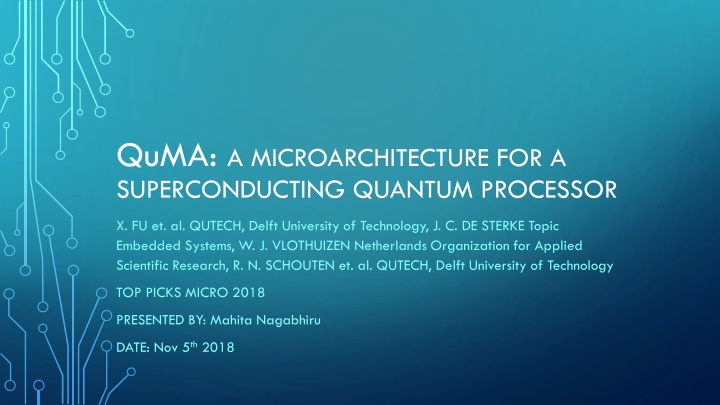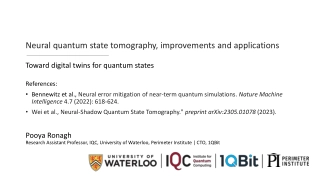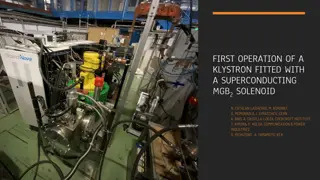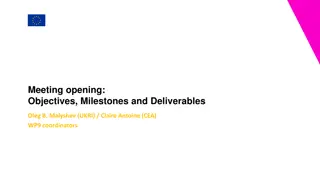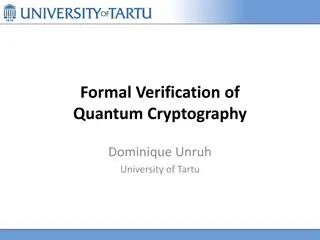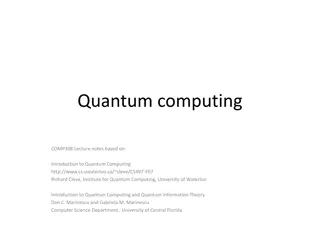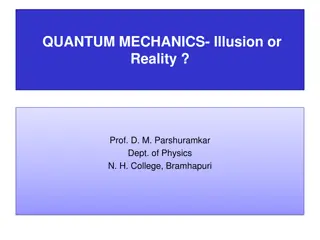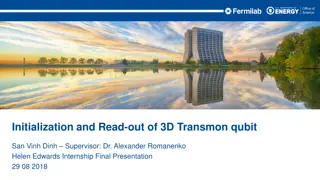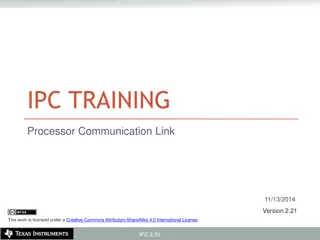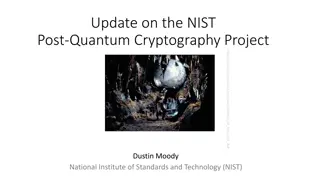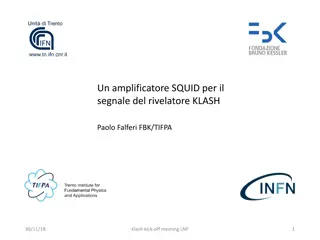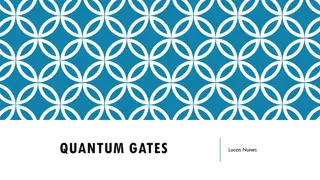Overview of QuMA: A Microarchitecture for a Superconducting Quantum Processor
This paper introduces QuMA, a quantum microarchitecture that bridges the gap between high-level algorithms and the quantum physical layer. It defines a multi-layered system stack for quantum computers, focusing on compiler support, quantum error correction, and the need for a micro-architecture framework. QuMA presents a quantum coprocessor as an accelerator to a classical host CPU, outlining the compilation process and the role of classical and quantum code in executing quantum operations efficiently.
Uploaded on Oct 07, 2024 | 4 Views
Download Presentation

Please find below an Image/Link to download the presentation.
The content on the website is provided AS IS for your information and personal use only. It may not be sold, licensed, or shared on other websites without obtaining consent from the author.If you encounter any issues during the download, it is possible that the publisher has removed the file from their server.
You are allowed to download the files provided on this website for personal or commercial use, subject to the condition that they are used lawfully. All files are the property of their respective owners.
The content on the website is provided AS IS for your information and personal use only. It may not be sold, licensed, or shared on other websites without obtaining consent from the author.
E N D
Presentation Transcript
QuMA: A MICROARCHITECTURE FOR A SUPERCONDUCTING QUANTUM PROCESSOR X. FU et. al. QUTECH, Delft University of Technology, J. C. DE STERKE Topic Embedded Systems, W. J. VLOTHUIZEN Netherlands Organization for Applied Scientific Research, R. N. SCHOUTEN et. al. QUTECH, Delft University of Technology TOP PICKS MICRO 2018 PRESENTED BY: Mahita Nagabhiru DATE: Nov 5th2018
MOTIVATION This paper provides the first systematic discussion of the functionality that fills the gap between high-level algorithms and the quantum physical layer. To this purpose, a multi-layered system stack for a quantum computer is defined.
KEY IDEAS PRESENTED Compiler support beyond logical QASM- logical QASM to physical QASM mapping (borrowed from their prior work). QISA + Micro-architecture: Quantum ISA with multilevel instructions, decoded to micro-code- both classical and quantum, dispatched to respective components with control/timing pulses. (crux of this paper) Discussion of future work for the proposed micro-architecture. (future/on-going work).
FROM CODE TO ISA: COMPILER SUPPORT Need for Hybrid compiler- Host (like GCC) + Quantum Accelerator Compiler (QAC). QAC is hardware agnostic but needs to know the right QEC code to map logical qubits to physical ones.
QUANTUM ERROR CORRECTION: RELEVANT TO THIS PAPER 1 data bit needs 2 ancilla bits for bit/phase correction. Thus, 1 logical qubit mapped to multiple physical qubits in surface code. (ancilla bits can be shared) see ninja star.
NEED FOR MICRO-ARCHITECTURE FRAMEWORK Prior to this paper, popular methods to controlling qubits were mainly based on autonomous arbitrary waveform generators (AWG) and data collection units. These methods were inefficient because of: high resource consumption long configuration times control complexity lack of scalability with the number of qubits.
QUANTUM MICRO-ARCHITECTURE: QuMA Quantum coprocessor seen as accelerator to a classical host CPU. Compiled code consists of Classical code from classical compilers like GCC to host CPU from main memory. Quantum code that contains Classical code for control information. Quantum code for quantum operations.
REVIEW OF CLASSICAL MICRO-ARCHITECTURE I-type R-type 0 5 6 10 11 15 16 20 21 31 0 5 6 10 11 15 16 31 opcode rs1 rs2 rd function opcode rs1 rs2/rd immediate 6 bits 5 bits 5 bits 5 bits 11 bits 6 bits 5 bits 5 bits 16 bits loads addr = Regs[rs1] + sign_extend(immediate) Regs[rd] = Mem[addr] load rd, #immed(rs1) stores addr = Regs[rs1] + sign_extend(immediate) Mem[addr] = Regs[rs2] store #immed(rs1), rs2 Regs[rd] = Regs[rs1] op sign_extend(immediate) register-immediate ALU operations op rd, rs1, #immed (e.g., add) I-type cond = (Regs[rs1] op 0) target = PC + 4 + sign_extend(immediate) PC = (cond ? target : PC + 4) conditional branches bopz rs1, #immed (e.g., bez, bnez, ) jump register / call register Regs[rd] = Regs[rs1] op Regs[rs2] register-register ALU operations op rd, rs1, rs2 (e.g., add) R-type Borrowed from ECE 463/563, Profs Conte/Rotenberg/Sair, Dept. of ECE,NC State University
QuMA: Quantum Control Unit Quantum code from main memory comes to QCU- A multilevel instruction decoding unit Execution controller takes care of: quantum code movement to Ex. Reg-file and Physical execution layer Classical code movement
QuMA: Physical Execution Layer Physical Microcode Unit: Converts micro-instructions at the Q control store, puts micro-operations at the QMB (Quantum microinstruction buffer) with timing info which in-turn are put into codeword triggers at the u-op unit.
QuMA: Physical Execution Layer Timing Control Unit has a Queue-based event timing control scheme issues event triggers with precise timing at nanosecond scale to the measurement discrimination unit MDU and the u-op unit.
QuMA: Quantum Classical Interface Quantum Classical Interface: Codeword-based event control scheme at codeword-triggered pulse generation unit (CTPG) produces analog input to the quantum processor based on codeword triggers. The MDU converts the analog output from the quantum processor into binary results.
QuMA: Quantum Classical Interface Each micro-op is associated with a timing pulse (related to its timing label) and codeword. Codeword is nothing but an index for this time pulse corresponding to this timing pulse into the CTPG or MDU units. CTPG and MDU units have fixed latencies and precise timing pulses and take care of the further Analog to digital conversion interfaces. This is claimed to be more precise and systematic instruction-driven and hence overcomes of the AWGs drawbacks.
QuMA: Quantum Classical Interface Fast and flexible feedback control is also possible in principle because the CTPG scheme does not require the waveform to be uploaded at runtime and codeword triggers this dynamically. The whole of QCI interface actually needs to be Technology dependent making the previous stages of micro-architecture Quantum technology agnostic making this very modular and adaptable.
EXPERIMENTAL SETUP Not Done: Writing measurement results from the MDU to the exchange register file. The automatic conversion from quantum instructions to quantum microinstructions Done: The timing management part of the physical microcode unit. the microinstruction set, QuMIS executed to from time cycle to cycle. QEC as a part of gate characterization experiment done using Randomization benchmarks.
OPEN PROBLEMS They talk about QISA and integrating classical and quantum instructions but discussion is limited to QEC- related classical components. Interaction between host CPU and Quantum co- processor is still unclear on the overall algorithm implementation. Single issue rate discussion so far- but reality of Quantum Algorithms is SIMD- like; so need for support extension for the same- Single-Operation-Multiple-Qubit (SOMQ) execution. There is a need for design of verification environment for their proposed architecture. Scalability: A tiled architecture consisting of multiple QuMA nodes with each node controlling tens of qubits would be a potential solution for scaling up a system using their architecture model but detailed communication mechanisms between these tiles has to be established. Even though the movement of data from digital to analog (Quantum) and back to digital is theoretically faster in their implementation, the CTPG still uses classical AWGs- just in a much more controlled fashion. Any developments of moving the AWGs functionality from room temperature to lower temperatures of Quantum Chip will make this entire movement much faster.
REFERENCES X. Fu et al., A heterogeneous quantum computer architecture, Proceedings of the ACM International Conference on Computing Frontiers, 2016. X. Fu et al., Pauli Frames for Quantum Computer Architectures , Proceedings of the 54th Annual Design Automation Conference 2017 M. D. Reed, Entanglement and quantum error correction with superconducting qubits, dissertation, Yale University, 2013 . C. G. Almudever et al., The engineering challenges in quantum computing, 2017 Design, Automation & Test in Europe Conference & Exhibition (DATE), 2017, pp. 836 845
